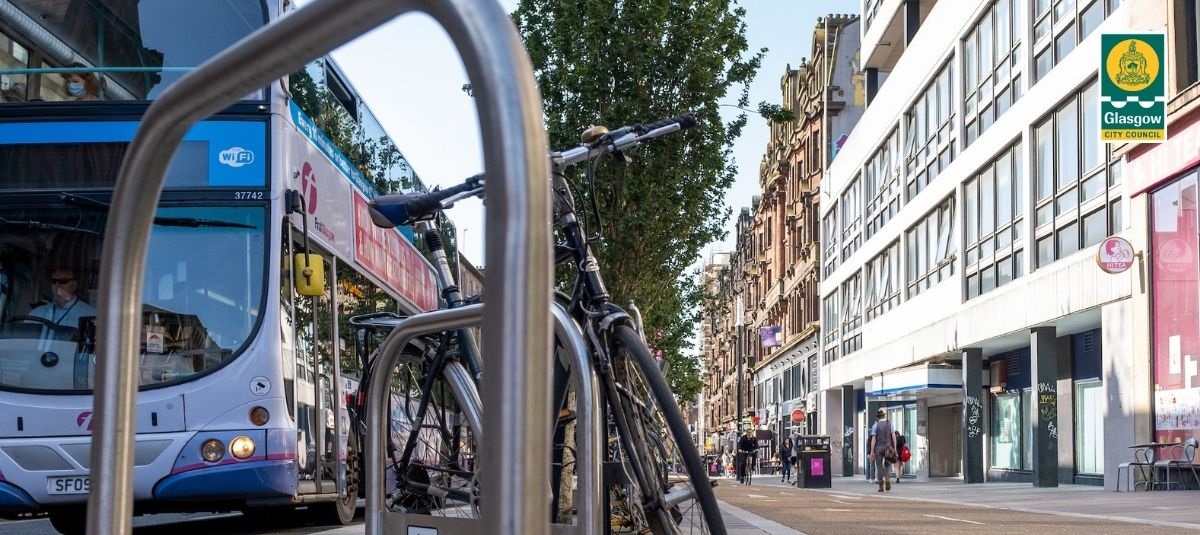Glasgow maps out sustainable transport future
Glasgow’s new transport strategy has mapped a course to a city network that tackles poverty, supports economic success, creates thriving, liveable neighbourhoods and plays a central role in the fight against climate change.

Following extensive consultation and preparation over the past year, a final policy framework for the Glasgow Transport Strategy has been set out that covers over 100 policies that provide a comprehensive vision for how to get about Glasgow in future. But with vehicle emissions accounting for a third of the city’s carbon output, changes to the transport system are regarded as a vital component in Glasgow’s effort to achieve carbon neutrality by 2030.
To support the city’s carbon reduction target, the new strategy sets out the ambition of reducing car vehicle kilometres travelled in Glasgow by at least 30% by 2030. The aim is to encourage travellers to opt for sustainable transport choices such as walking, wheeling or cycling or public transport wherever possible so there is less need to travel by car.
Support for the 30% target comes from initiatives such as the council’s Active Travel Strategy, which includes a proposal to build a city-wide network of segregated cycling infrastructure, and the Liveable Neighbourhoods initiative that will support more local access to essential services and enable shorter, local trips by walking, wheeling and cycling. Major projects such as the Clyde Metro, which recently received backing in the Scottish Government’s Strategic Transport Projects Review, and increased bus priority on the roads are also key components in the effort to provide a world-class public transport network that draws people from their personal vehicles.
With 27% of vehicle journeys in Glasgow 1km or less, Councillor Anna Richardson, city convener for sustainability and carbon reduction, believes there is significant potential for a widespread switch to sustainable transport.
Councillor Richardson said: “A great many trips in vehicles across the city are short and could realistically be achieved by other means. Our task as a council is to ensure there are viable alternatives that support walking, wheeling or cycling or public transport to help reduce car use.
“Cars and other private vehicles will clearly continue to be part of Glasgow’s transport future. But time and again people indicate they would cycle more if it felt safer to do so or the way that public spaces are designed can deter active travel in local communities. Initiatives such as our Active Travel Strategy and our Liveable Neighbourhoods programme are all about creating a better balance on how Glasgow’s streets are used and encouraging people to leave the car behind wherever possible.
“Making in-roads on our car use is essential if we are to bring down the carbon emissions that drive climate change. But supporting sustainable transport choices also means we can make city streets safer and more attractive places to be, which in turns helps to improve quality of life for local residents.
“The new transport strategy fully recognises how important transport is to our daily lives and the overall success of the city. The far reaching policy objectives in the strategy create a vision of a healthy and thriving city but also a sustainable Glasgow that is prepared for the challenge of climate change.”
Following consideration at the Environment, Sustainability and Carbon Reduction Policy Committee, the final policy framework of the Glasgow Transport Strategy will now go before the council’s City Administration Committee for final approval.
Meanwhile, plans to build 270km of active travel infrastructure throughout Glasgow could provide a £1.843 billion benefit for the city.
First unveiled in October last year, the proposed network would add to existing safe and segregated routes in Glasgow and allow anyone who cycles to reach most of the city within 30 minutes by bike.
It is estimated that the new infrastructure could cost up to £475m to build over the next ten years. But in a report presented at the council’s Environment, Sustainability and Carbon Reduction Policy on February 1, an analysis by an independent consultant found the network could support a wide range of environmental, economic, health, road safety and community benefits for the city.
The analysis has been used to form a strategic business for the active travel plan, which amounts to a £1.843bn gain for Glasgow over the next ten years. Considered to provide a high cost/benefit ratio when compared to the estimated construction costs, the £1.843bn figure was also found likely to increase over time as accident rates dropped as active travel becomes safer.
Councillor Anna Richardson believes the strategic business case adds further impetus to the drive to create a city network for active travel that would form part of Glasgow’s fight against climate change.
Councillor Richardson said: “Our active travel plan is a key part of our effort to decarbonise Glasgow’s transport network. Almost 30% of vehicle journeys in Glasgow are less than 1km and so there is significant potential to reduce the carbon emissions created during those short trips.
“By creating a network of safe and segregated active travel infrastructure, we want to see walking, wheeling and cycling become the first choice for everyday journeys all across the city. Encouraging a shift to active travel will reduce the carbon impact of how we get about Glasgow, but it will also help to improve the overall health and well-being of our citizens.
“The strategic business case clearly recognises the many other positive differences a city network for active travel can have for Glasgow. Improved air quality, less congestion on our roads, increased footfall on local high streets, less strain on our health services and greater use of city streets as places for play and socialising are all identified as possibilities that flow from the creation of a city network.
“The fact a figure as large as £1.8 billion can be attributed to the changes that would come from building a city network is remarkable. But the real prize is the huge potential for improving the quality of life in communities all across the city that could be built upon on a city network for active travel.”
Further work on the strategic business case is expected to be undertaken alongside the development of a detailed plan to deliver the network that is due to be produced by this summer.
However, it is intended that the design of the network will draw upon lessons learned in Glasgow but also from best practice found in other European cities such as Paris, Copenhagen and Seville where significant active travel infrastructure is already in place.
Following discussion by councillors at the Environment, Sustainability and Carbon Reduction Policy Committee, Glasgow’s Active Travel Strategy 2022-31 has been referred to the council’s City Administration Committee for final approval.



















